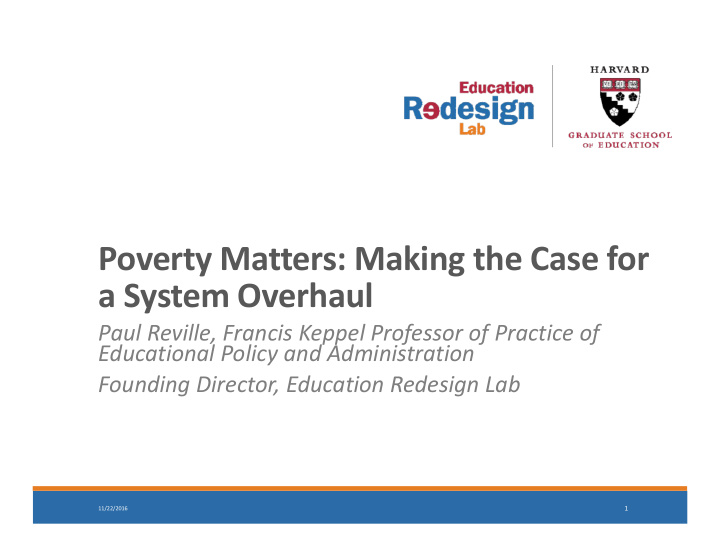



Poverty Matters: Making the Case for a System Overhaul Paul Reville, Francis Keppel Professor of Practice of Educational Policy and Administration Founding Director, Education Redesign Lab 1 11/22/2016
Major Strategies in 1993 Reform Act • Standards of Accountability • Choice • Improvement of Curriculum & Instruction • Leadership Development • Improvement of Teaching (from teacher testing to professional development to teacher evaluation) • Use of Data • School & District Turnarounds • Finance Reform 2 11/22/2016
Implementation Success • Leadership: Deep, Non ‐ Partisan, Persistent • Clear, Powerful Equity and Excellence Rationale • High Expectations, Standards, and Stakes • Significant Investment in Capacity and Equity • Inclusive Implementation Approach • Long ‐ term Commitment 3 11/22/2016
Results NAEP, The Nation’s Report Card: Massachusetts’ rank among all states and jurisdictions 2005 2007 2009 2011 2013 2015 Grade 4 1 st 1 st 1 st 1 st 1 st* 1 st Reading Grade 8 1 st 1 st* 1 st* 1 st* 1 st* 1 st* Reading 1 st 1 st 1 st* 1 st* 1 st* 1 st* Grade 4 Math 1 st 1 st 1 st 1 st 1 st 1 st* Grade 8 Math * statistically tied with other states 4
Results ELA – All Tested Grades Mathematics – All Tested Grades 90 90 80 80 70 70 Percent Proficient & Above Asian 60 60 White 50 50 Black Hispanic/Latino 40 40 Low Income 30 30 ELL SPED 20 20 10 10 0 0 2008 2009 2010 2011 2012 2013 2014 2008 2009 2010 2011 2012 2013 2014 5 11/22/2016
“Education, then, beyond all other devices of human origin, is the great equalizer of the conditions of men, the balance ‐ wheel of the social machinery.” Horace Mann, 1848 6 11/22/2016
Ed reform set out to tackle inequity, to achieve “all means all.” Yet after 20+ years of education reform, there is still a persistent, iron law correlation between socioeconomic status and educational achievement and attainment. 7
= 1 school district Relationship between Socioeconomic Status and Educational Achievement Graphic from the New York Times , based on 2016 work done by Sean Reardon, Center for Education Policy Analysis, Stanford University. 8 11/22/2016
Behind these unequal outcomes are income ‐ based gaps in opportunities, supports, and life experiences 9
Why America Needs a New Engine for Education 30 million word difference! Hart, B., & Risley, T. R. (2003). The Early Catastrophe: The 30 million word gap by age 3. American Educator , Spring 2003 , 4–9. 10 11/22/2016
11
Conclusion: Education Reform Has Not Gotten Us to the Goal of “All Means All” What do the data show? Substantial gaps in achievement among different subgroups persist. The reforms of the past two decades ‐ notably standards, accountability, and choice ‐ were necessary but not sufficient. https://drgradysmith.files.wordpress.com/2014/12/idpwd ‐ photo.jpg?w=350&h=200&crop=1 12
Why does all this matter more than ever before? 13
Another New Majority: Low ‐ Income Kids Southern Education Foundation. (2015). A new majority: Low income students now a majority in the nation’s public schools . Atlanta, GA. 14
The Majority ‐ “Minority” in U.S. Public Schools As of 2014, for the first time, fewer than half of public school students are White. Racial/Ethnic Makeup of Public School Students 2014 1% 2.80% 5.30% 25.40% 49.90% ^ Data projected for 2015. Kena, G., Musu ‐ Gillette, L., Robinson, J., Wang, X., Rathbun, A., Zhang, J., Wilkinson ‐ Flicker, S., Barmer, A., and Dunlop Velez, E. (2015). The Condition of Education. 15.60% < Data retrieved from the National Center for Education Statistics. White Black Hispanic Asian/Pacific Islander American Indian/Alaska Native 2 or More 15 11/22/2016
Why? Was it the Wrong Goal? Did We Choose the Wrong Strategies? Was it the Wrong Delivery System? 16
Outmoded, Outdated Design 17
One Size Fits All 18
Insufficient Time 19
Doesn’t Address the Impact of Poverty 20
What do we need? A new, enhanced system of education – a new vision. 21
Defining Success Students can get and hold a 21st century, high-skill, high-knowledge job that enables them to support a family Students become informed citizens and active leaders Students become heads of families and lifelong, fulfilled learners 22
Primary Focus Areas Customize education to the needs of each Personalize and every child learning 23
24
Primary Focus Areas Customize education to the needs of each Personalize and every child learning Integrate Integrate education with health and social services services 25
There is a well ‐ documented relationship between poverty and poor health outcomes. 26
27
Primary Focus Areas Customize education to the needs of each Personalize and every child learning Integrate Integrate education with health and social services services Provide all kids with access to high-quality Out-of-school out of-school learning opportunities learning 28
Virtually all of the advantage that wealthy students have over poor students is the result of differences in the way privileged students learn when they are not in school…. America doesn’t have a school problem. It has a Summer vacation problem. -- Malcolm Gladwell, Outliers , 2011 29
Mission & Strategy Personalized Systems of Study and Study and Education & Child/Youth document best document best practices and practices and Development barriers to barriers to innovation innovation Inform federal, Inform federal, state, and local state, and local Student ‐ Equal Access policy and build policy and build Partner with cities Partner with cities Integrated public will public will Centered, to Expanded to implement to implement Health & Customized Learning innovative innovative Social Services Learning Opportunities education models education models
Contact: Jennifer_Davis@gse.harvard.edu Paul_Reville@gse.harvard.edu 50 Church Street 617 ‐ 495 ‐ 6784 4th Floor edredesign.org Cambridge, MA 02128 Twitter: @EdRedesignLab 11/22/2016 31
Recommend
More recommend